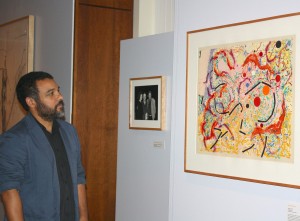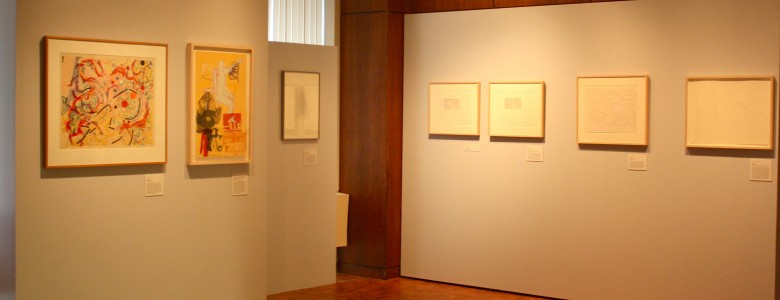As part of Trisha Brown: In the New Body, drawings, writings, and other works by Trisha Brown and her collaborators—including by Robert Rauschenberg, Elizabeth Murray, and Nancy Graves—are displayed in an exhibition organized by Bryn Mawr College’s department of Special Collections. Trisha Brown: (Re)framing Collaboration An Exhibition of the Art of Trisha Brown and Her Collaborators opens a window on how the visual arts informed Brown’s choreography, and presents drawings and paintings that stand on their own as works of artistic expression. Curators Brian Wallace and Matthew Feliz shared their thoughts in a quick interview on their thinking behind the exhibition.
 Q: What do you find compelling about Brown’s drawings?
Q: What do you find compelling about Brown’s drawings?
Matthew Feliz: I’m fascinated by the ways in which Brown’s approach to drawing evolved over the course of her career and in relation to her choreography/dance. I found the drawings that she did in the early 1990s to be particularly compelling—drawings that grew out of her sustained engagement with the music of Johann Sebastian Bach. The visual traces of her markmaking record acts of intuition and improvisation, responses to and investigations into Bach’s highly complex musical structures—repetition, theme, and variation.
Brian Wallace: Brown’s visual works illuminate her methods and insights in the realms of choreography and performance, but they don’t need that connection to be meaningfully expressive. They embody acts of exploration and resolution in ways that are inherent to visual art—they visually link formal and narrative problems and solutions; they pose a spectrum of issues ranging from the personal to the profound, and they span ancient and contemporary procedures of representation while they reveal Brown’s parallel investigations and conclusions in movement and space.
Q: Are there some common threads, from her collaborators’ art and artistic sensibilities, that you strike you in a way as to think, well, of course they became collaborators?
Brian Wallace: Brown, Robert Rauschenberg, and Laurie Anderson—the artists whose works I know best—are all selective, even attenuated, but nonetheless voracious engagers with and redeployers of the whole panoply of visual culture. They strike me as passionate and knowing quoters and borrowers, as exuberant but not unreflective cutters and pasters, and as instructively divergent representatives of post-modernism. Too, their image of the body is a fascinating palimpsest.
Matthew Feliz: We included a couple of photographs by Babette Mangolte that document two of Brown’s early performances. These works gesture rather tantalizingly towards the intersections of communities of dancers/choreographers/performance and experimental filmmakers during the 1960s and 1970s.
Brian Wallace: The intergenerational aspect of the exhibited collaborations—and these artists have engaged in many other birth-year-diverse projects – is also noteworthy: these artists, at quite different moments in their respective careers, generously, carefully, and ambitiously offered and took inspiration from one another.
Q: How did you go about selecting work for this exhibition, what were you looking for?
Brian Wallace: We—Matt, Lisa Kraus, and I—wanted to find works that would illuminate Brown’s working methods, attract and engage a visual arts audience and a performance-oriented audience, and give the members of those audience some category problems as well as some information to mull over, hopefully with one another—and, ideally, with students. So, groups of works keyed to performances audiences will experience as part of the larger Brown project; sets of works in completely different media that share clear affinities; an arrangement of works that show Brown’s expressive and intellectual range.
Matthew Feliz: The works selected, photographs of Brown’s early career (late 60s to early 1970s) and her drawings and prints by other artists, allowed us to create both a chronological structure and a set of thematic groupings that situate Brown’s drawings within the broader context of her own dance practice.
Brian Wallace: The intimate scale of the gallery was used to intensify the impact of Brown’s works: the varied viewing dynamics of video/audio material, large-scale drawing, small notes capturing fugitive thoughts, and dense, compact explorations of knotty procedural problems were carefully considered when the list and location of the works was reviewed and finalized.
Trisha Brown: (Re)framing Collaboration, An Exhibition of the Art of Trisha Brown and Her Collaborators continues until December 11 at Bryn Mawr College, Canaday Library, Class of 1912 Rare Book Room Gallery, 101 North Merion Avenue, Bryn Mawr, PA 19010. Open daily 11am–4:30pm. Free.

